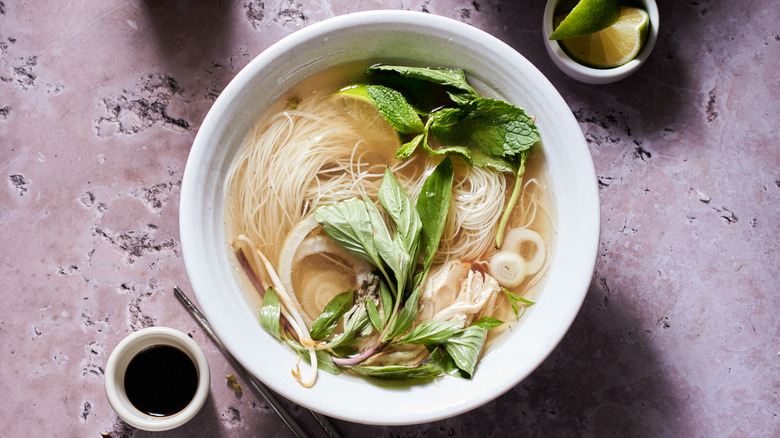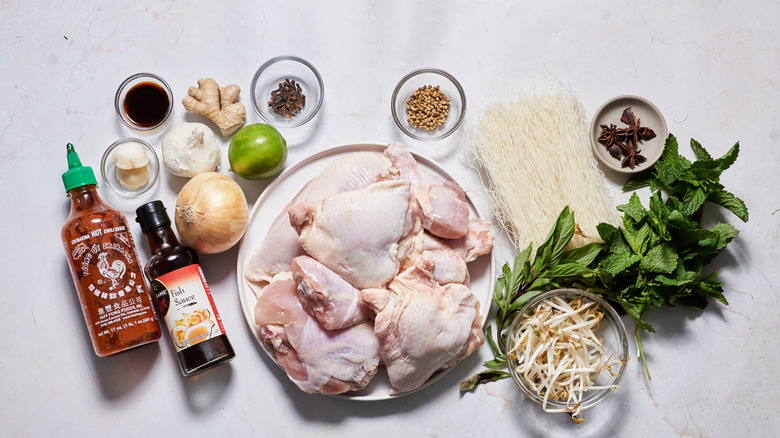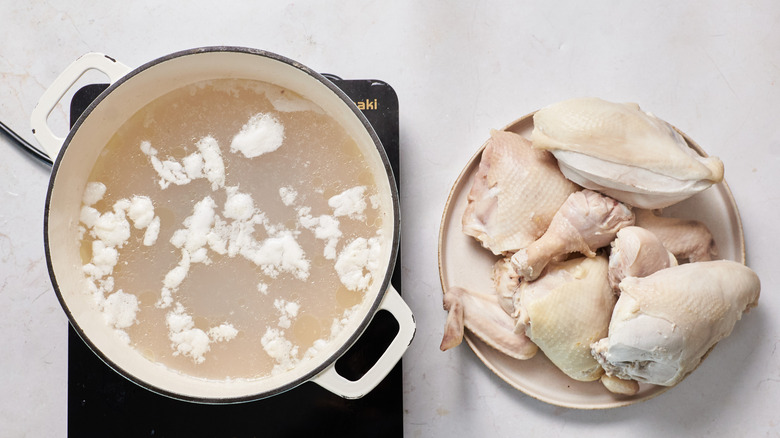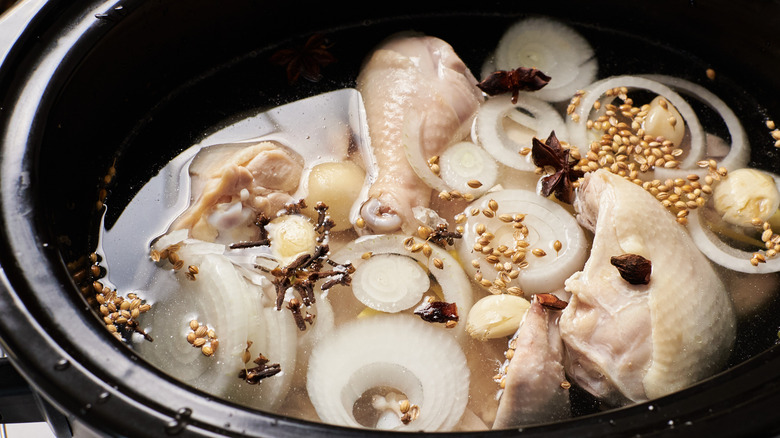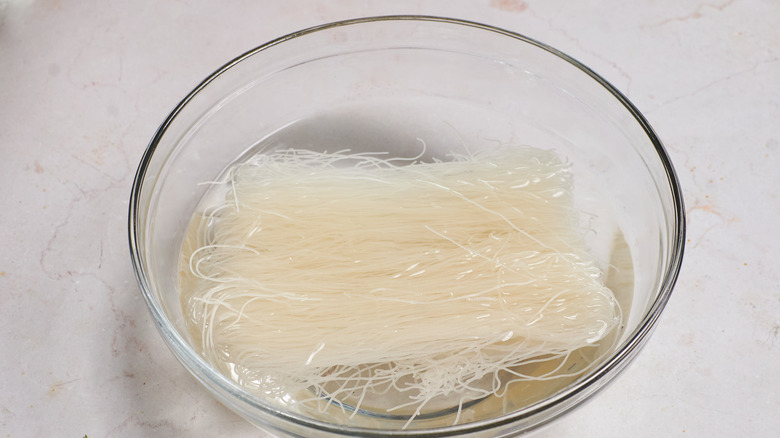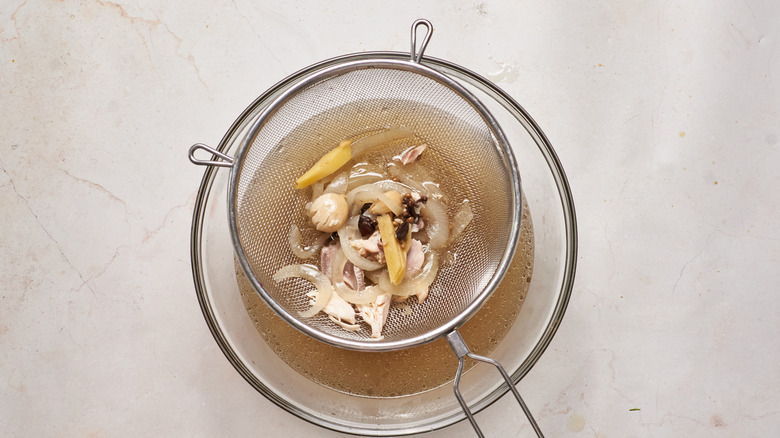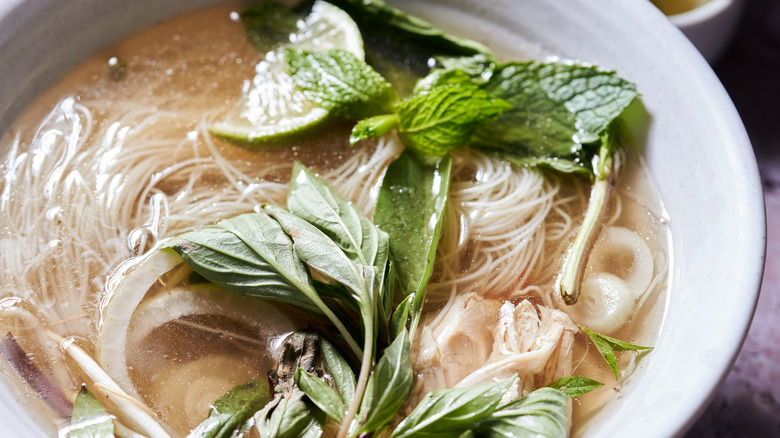Crockpot Chicken Pho Recipe
Have you ever had a really bad cold, or experienced a particularly gloomy day, and really needed a big bowl of soup? In case you aren't familiar, let us introduce you to the perfect rainy-day remedy: pho. A Vietnamese soup, pho is traditionally made up of clear, silky bone broth, thin vermicelli rice noodles, and raw sliced beef, all of which help make it absolutely delicious and particularly comforting.
Pho can be made as a 30-minute meal using store-bought broth, but you'd be missing what makes pho so special. In traditional preparations, blanched beef bones are simmered slowly for up to 12 hours to make a faintly herby, savory broth with a nearly-translucent color. But half a day on the stove? It can be hard to manage.
Enter the slow cooker. This low-heat vessel can make a beautiful pho broth with hardly any worry or prep. In this recipe developed by Michelle McGlinn, chicken is used for a silky and flavorful pho gà, a savory but lighter version of the traditional pho bo or beef pho. The tender chicken is pulled into buttery pieces to eat with the noodles and broth, and the topping options make for an endless adventure. It's the perfect recipe for a rainy day, a household full of head colds, or just a cozy winter dinner party. Plus, it takes hardly any effort at all — perfect for when you, yourself, need the TLC.
Everything you need for Crockpot chicken pho
What's great about pho is that most ingredients can be found in just about any grocery store and are likely already in your pantry. For example, you'll need cloves, star anise, and coriander; spices that are common if you like making chai teas or spiced hot toddies. You'll also need an onion, some garlic, and fresh ginger, as well as about 8 cups of water. For the chicken, we recommend using a whole fryer chicken, which will have the most bones and offer the most flavor. If you can't score a whole chicken (or don't want to carve one), you can use bone-in chicken thighs and legs instead.
Some harder-to-find items might be the fish sauce, palm sugar, and rice noodles. If you can't find fish sauce, use soy sauce, and you can swap the palm sugar with standard light brown sugar. The rice noodles are an important texture in pho, but if you can't find the semi-translucent, uber-thin noodles, try angel hair pasta or ramen instead.
For toppings, we recommend fresh mint, fresh Thai basil, lime wedges, hoisin sauce, bean sprouts, and Sriracha. You can get creative here, adding fried onion, cilantro, peanuts, spinach, or even jalapeños.
Blanch the chicken
The secret to great pho broth is blanching the meat to remove impurities, fat, and blood. Not only does blanching clean the meat and bones, but it enhances the flavor, leading to a better broth. The process is quick and easy, though mildly discomforting. Just bring a large pot of water to boil and drop in the chicken. If the pot is large enough, you can boil the whole chicken at once — there's no need to worry about crowding. Boil for about 5 minutes or so, until the chicken is white and clean. Remove the chicken and toss the water you used to blanch it in.
Boiling chicken isn't the best smell, we know — if you have to skip it, you can, but your pho broth won't be as clear and clean. If you don't blanch your chicken, plan to skim fats from the top of the broth and fine strain.
Throw it all in a slow cooker
Now's the easy part: put the chicken, water, aromatics, sugar, fish sauce, and spices in the slow cooker and turn it to low for 8 to 9 hours. If you are a little shorter on time, turn the slow cooker to high and cook for 4 to 5 hours instead. Chicken is a slow cooker's best friend; it doesn't need a lot of time to become tender, so cooking on either high or low will work perfectly. And if you're really, really short on time? You can get away with 3 hours on high.
Soak the noodles
The type of rice noodle used in pho doesn't actually need to be boiled, especially since it ends up in hot pho broth. Because the noodles are thin and made with rice instead of wheat, the hot water is enough to cook them through so place the noodles in a bowl and cover with hot water, then let sit for around 10 minutes. Do this right before serving, or the noodles will dry out and become gummy.
Strain the broth and shred the chicken
Take the chicken out of the slow cooker and shred using two forks. Don't worry too much about fishing all the bones out of the broth, since you'll be straining the liquid anyways. To strain, remove the basin from the slow cooker and carefully pour it into a large bowl fitted with a mesh strainer. If the basin is too hot or heavy, use a handheld strainer to fish as many solids out as possible. If you blanched the chicken first, there should be mostly large pieces.
Serving chicken pho
Now's the best part of the pho experience: putting it all together to eat. Just about any pho restaurant worth its salt is going to give you a steaming bowl of pho plus a dish full of toppings that you can add in too, either all at once or bite-by-bite. To add a salty flavor, pour in some hoisin. To add heat, add some Sriracha. Some crunch? Try the bean sprouts. And to get that classic pho flavor? Add plenty of fresh mint and basil leaves. And of course, don't forget to add plenty of that buttery shredded chicken.
To store the pho, we recommend saving the noodles, chicken, and broth in separate airtight containers to avoid mushy noodles and soggy chicken. All of these elements will save for about a week and can be reheated simply in the microwave or gently on the stove. Pho goes well with other Vietnamese favorites like chả giò spring rolls or a classic bánh mì, making it a full and delicious meal.
Crock Pot Chicken Pho Recipe
This Crockpot chicken pho combines tender chicken, rice noodles and a light broth into a delicious comforting dish. The toppings make it an endless adventure.
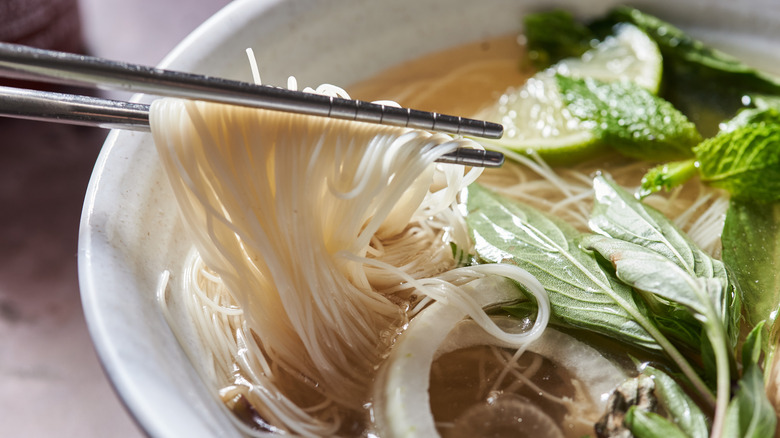
Ingredients
- 4 pounds whole bone-in fryer chicken, carved into pieces
- 1 tablespoon whole cloves (about 10–15 cloves)
- 4 star anise
- 1 tablespoon whole coriander seed
- 1 yellow onion, sliced, plus more for serving
- 3 cloves garlic, peeled and smashed
- 1 3-inch knob ginger, peeled and chopped
- 2 tablespoons (or 2 small pieces) palm sugar
- ¼ cup fish sauce
- 8 cups water
- 8 ounces vermicelli rice noodles
- Thai basil, for topping
- Mint, for topping
- Bean sprouts, for topping
- Sriracha, for topping
- Hoisin sauce, for topping
- Lime, cut into wedges, for serving
Directions
- To blanch the chicken, bring a large pot of water to boil. Once boiling, add chicken pieces, working in batches as needed. Boil until chicken becomes white, about 5 minutes, then remove.
- Add blanched chicken to a Crockpot. Cover the cloves, star anise, coriander, onion, garlic, ginger, palm sugar, fish sauce, and 8 cups of water. Cook on high for 4 to 5 hours, or low for 8 to 9 hours.
- Before serving, prepare the noodles. Place dried noodles in a bowl and cover with hot water. Soak until softened, about 10 minutes.
- Remove chicken from the slow cooker and shred. Chicken will fall off the bone easily with no resistance.
- With the chicken removed from the slow cooker, strain the liquid into a large bowl, discarding any remaining solids.
- To build the pho, divide noodles into bowls. Ladle the broth over the noodles. Add toppings as desired; add pulled chicken, sliced onion, mint leaves, basil leaves, and bean sprouts. Then, add hoisin sauce and Sriracha for salty or spicy flavor.
- Serve warm with lime wedges.
Nutrition
| Calories per Serving | 833 |
| Total Fat | 46.4 g |
| Saturated Fat | 13.2 g |
| Trans Fat | 0.3 g |
| Cholesterol | 226.8 mg |
| Total Carbohydrates | 40.4 g |
| Dietary Fiber | 2.2 g |
| Total Sugars | 4.7 g |
| Sodium | 1,239.9 mg |
| Protein | 60.0 g |
